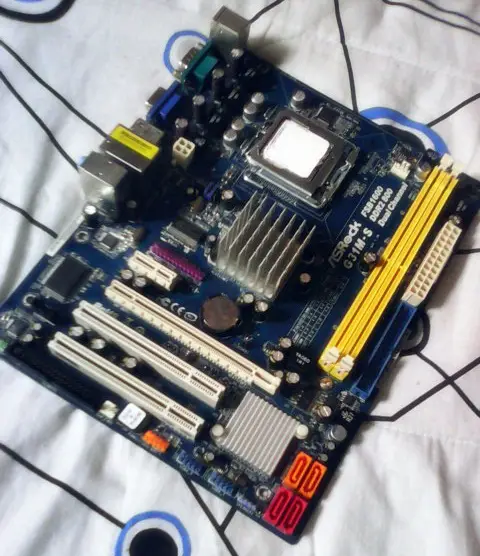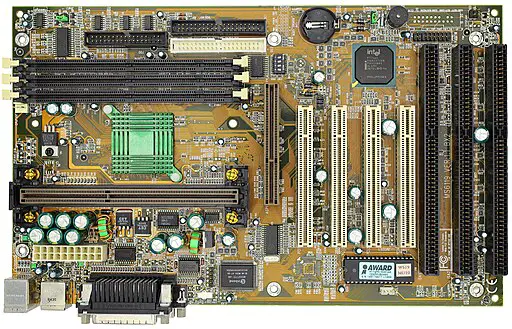Micro ATX motherboards are smaller and have fewer expansion slots, while ATX motherboards are larger with more slots for components.
TL;DR Micro ATX Motherboards Vs. ATX Motherboards
Micro ATX motherboards are smaller in size, making them ideal for compact builds or systems with limited space. They offer a great balance between performance and affordability.
ATX motherboards are larger and provide more expansion slots and connectivity options. They are better suited for high-performance gaming rigs or systems that require extensive customization.
What is a Micro ATX Motherboard?

Micro ATX motherboards, also known as µATX or mATX, are a smaller form factor compared to their larger counterpart, the ATX motherboard. They were designed with space-saving in mind while still providing essential features for building a functional computer system.
In terms of size, Micro ATX boards measure 9.6 inches by 9.6 inches (244mm x 244mm), whereas typical ATX boards are larger at around 12 inches by 9.6 inches (305mm x 244mm). This compact size makes Micro ATX motherboards ideal for smaller cases and builds where space is limited.
Despite their smaller dimensions, Micro ATX motherboards often feature similar functionality to full-sized ones. They typically have multiple expansion slots for adding additional components such as graphics cards or sound cards. Additionally, they offer support for various types of storage devices like SATA and M.2 drives.
Another notable aspect of Micro ATX motherboards is that they usually have fewer RAM slots compared to their larger counterparts. While standard ATX boards commonly provide four DIMM slots for RAM modules, most Micro ATX variants come with two or sometimes even just one slot.
Micro ATX motherboards strike a balance between size and function. They are an excellent choice if you want a compact build without sacrificing too many features or compatibility options.
What is an ATX Motherboard?

An ATX motherboard, also known as Advanced Technology eXtended motherboard, is a type of motherboard that follows the industry standard size and layout specifications set by Intel. It was introduced in the 1990s and has since become one of the most commonly used form factors for desktop computers.
ATX motherboards are larger than micro ATX motherboards and typically measure around 12 inches by 9.6 inches. This larger size allows for more expansion slots and connectors, making them suitable for high-performance systems or those with multiple add-on cards.
One key feature of ATX motherboards is their power supply connector placement. Unlike micro ATX boards which have their power connectors located near the CPU socket, ATX boards have these connectors positioned towards the back edge of the board. This design makes cable management easier and helps improve airflow within the system.
Another advantage of ATX motherboards is their support for multiple graphics card setups through SLI (Scalable Link Interface) or CrossFire technology. This makes them ideal for gamers or users who require powerful graphics processing capabilities.
In terms of connectivity options, most modern ATX motherboards come equipped with a range of ports including USB Type-A and Type-C, HDMI, DisplayPort, Ethernet, audio jacks, SATA ports for storage devices, PCI Express slots for expansion cards like Wi-Fi adapters or sound cards.
Micro ATX Motherboards Vs. ATX Motherboards – Key Differences
| Aspect | Micro ATX (mATX) Motherboards | ATX Motherboards |
|---|---|---|
| Size | Smaller form factor, typically 9.6" x 9.6" (24.4 cm x 24.4 cm). | Standard larger form factor, typically 12" x 9.6" (30.5 cm x 24.4 cm). |
| Expansion Slots | Fewer PCIe and RAM slots, typically 2-4 RAM slots and 2-3 PCIe slots. | More PCIe and RAM slots, typically 4-8 RAM slots and 4-7 PCIe slots. |
| Ports and Connectors | May have fewer rear I/O ports and connectors compared to ATX. | Offers a more extensive array of rear I/O ports and connectors. |
| Multi-GPU Support | Limited support for multi-GPU configurations, typically up to 2 GPUs. | Better support for multi-GPU setups, often accommodating 3 or more GPUs. |
| Compact Builds | Suited for compact PC cases and space-constrained builds. | Typically used in mid-tower and full-tower cases, allowing for larger configurations. |
| Price | Generally more budget-friendly due to the smaller size and fewer features. | May be more expensive due to additional features and expansion options. |
| Cooling and Airflow | Smaller size can sometimes lead to less efficient cooling and airflow compared to ATX. | Larger size provides more room for cooling solutions and airflow management. |
| Compatibility | May require more planning for component compatibility in smaller cases. | Offers greater flexibility in terms of component compatibility and customization. |
| Use Cases | Ideal for compact and budget builds, HTPCs, and smaller gaming rigs. | Suitable for gaming, content creation, and enthusiast PCs with multiple components. |
Micro ATX Motherboards Vs. ATX Motherboards – Advantages and Disadvantages
Micro ATX (mATX) Motherboards:
Advantages:
- Compact Size: Ideal for smaller PC cases and space-constrained builds, including HTPCs and compact gaming rigs.
- Budget-Friendly: Generally more affordable due to their smaller size and fewer features.
- Energy-Efficient: Consumes less power compared to ATX, making it a good choice for energy-efficient systems.
- Ease of Assembly: Easier to work with during assembly and component installation.
- Sufficient for Most Users: Suitable for mainstream users who don’t need extensive expansion options or multiple GPUs.
Disadvantages:
- Limited Expansion: Fewer PCIe and RAM slots may limit the upgrade potential and component choices.
- Fewer Features: Typically have fewer rear I/O ports and connectors compared to ATX.
- Not Ideal for Enthusiasts: May not be suitable for power users, gamers with multi-GPU setups, or those requiring extensive connectivity.
- Cooling Challenges: Smaller size can sometimes lead to less efficient cooling and airflow, potentially affecting system performance.
ATX Motherboards:
Advantages:
- Extensive Expansion: Offers more PCIe and RAM slots, allowing for a wide range of component choices and multi-GPU setups.
- Feature-Rich: Provides a comprehensive array of rear I/O ports and connectors for various peripherals and devices.
- Customization: Offers greater flexibility for component compatibility, customization, and overclocking.
- Optimal Cooling: Larger size provides ample room for cooling solutions and efficient airflow management.
- Enthusiast-Friendly: Ideal for power users, gamers, content creators, and enthusiasts requiring high-performance configurations.
Disadvantages:
- Size and Space: Requires larger PC cases and may not be suitable for compact builds or small spaces.
- Costly: Typically more expensive due to additional features and expansion options.
Power Consumption: Consumes more power than mATX motherboards, making it less energy-efficient. - Complex Assembly: Assembly and cable management can be more challenging in larger cases.
Image Credits
Featured Image By – Fuzzy Mannerz from Pixabay
Image 1 By – Julianprescott2604juuly, CC BY-SA 4.0, via Wikimedia Commons
Image 2 By – Mister rf, CC BY-SA 4.0 , via Wikimedia Commons









